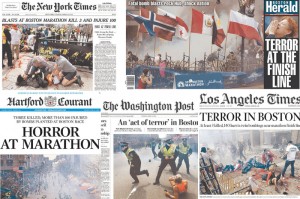Bloodshed in the news – dealing with graphic images
Every natural disaster, shooting, terror attack or war nowadays triggers a flood of horrifying and violent images. Gone are the days when only press photographers captured grief and terror with their lenses. In the digital age, bystanders can also snap shots of severed limbs and burnt corpses with their phones and cameras and upload them directly online.
How should media organizations handle such graphic images? When is it justifiable to publish photographs of the injured, the dying and the dead? Is it sensationalism to splash the bloodied body of Libya’s dead dictator Muammar Gaddafi across the front page of a newspaper? Is it appropriate to print photos of children killed by bombs in Syria? What about the images of victims, some with shredded limbs, that were published following the Boston marathon bomb blasts?
In her 2003 book looking at representations of atrocity, “Regarding the Pain of Others”, US author Susan Sontag wrote, “Harrowing photographs do not inevitably lose their power to shock. But they are not much help if the task is to understand. Narratives can make us understand. Photographs do something else: they haunt us.”
To help journalists decide whether to publish a certain images, German journalist Simon P. Balzert has composed a code of ethics for the use of graphic images. Balzert’s experience on the topic stems from research for his thesis which compared the publication of explicit images in German and Spanish newspapers (the result – Spanish newspapers published images of the dead and wounded significantly more often that German papers).

Simon P. Balzert
The guidelines though aren’t about presenting journalists with a fool-proof recipe for dealing with explicit images. “It always depends on the context,” Balzert said.
“Sometimes it is important to publish graphic photographs in order to document the horrors of war. For example, politicians may be interested in propagating the myth that it is a clean war,” he said.
- Before publication, journalists should ensure the photograph isn’t being printed solely for its shock or entertainment value, or for purely aesthetic reasons. Rather, the image should be chosen because it conveys pertinent and newsworthy information.
Before publication, journalists should see if it is possible to avoid publishing the photograph by conveying the information contained in the image in another manner. - Journalists should try to publish those images which are most emotionally appealing and least shocking. Instead of using a photo of a dead child, for example, publishing a picture of a child’s clothes covered with blood conveys the same message but is less upsetting.
- Journalist should apply the same standards to the use of graphic images of events in other countries as they would to the use of images from their own country. This avoids prejudices about other countries and other cultures.
- Journalists should avoid general rules such as “no photos of corpses”. Rather, they should decide which is the most suitable image on a case by case basis. Death and public discussion about death are part and parcel of an enlightened society and shouldn’t be inhibited by the media.
- Journalists should ensure that their publication sets aside sufficient space for an accompanying comment or text. If this space isn’t available then they shouldn’t publicize the image.
- Journalists should justify the use of a graphic image in an accompanying text (the picture caption doesn’t usually allow enough space for this). If possible, journalists should use an appropriate place in the publication to warn readers that a photo of a graphic nature follows.
- Journalists need to be aware that continued publication of graphic images lessens their overall effect. Therefore, they need to ensure that the publication of each explicit image is absolutely necessary.
- If journalists believe the publication of a graphic image is justified, they shouldn’t refrain from publishing the image because of concerns about whether it is appropriate for children or the audience’s reaction.
- In weighing up the pros and cons of an explicit image, journalists should concentrate on the context of the photograph and not allow themselves to be swayed by the codes of ethics of other media organizations.
- Journalists need to be aware that images on the printed page can leave a stronger impression than online images. They should consider publishing particular graphic images only online. That way readers can choose for themselves if they wish to view an image or not.
- Terrorist attacks often aim to maximize publicity. Journalists should therefore carefully weigh up the public benefits of publishing such images against the need for restraint.
- Journalists should be especially careful about publishing graphic images that were taken a while ago. When an image is no longer newsworthy, its publication is difficult to defend. Victims or their loved ones can suffer emotional distress and harm by suddenly being confronted with such images.
- Journalists should always consult with other editorial staff if they are in doubt about whether to publish certain images. However, journalists need to remember that they and their colleagues might have less inhibitions about seeing graphic photographs than average members of the public.
- Journalist need to consider the layout of the page when publishing graphic images. Readers tend to be more disapproving of an image’s publication when a headline or an advertisement focuses attention on the image.
- Journalists shouldn’t sensationalize explicit photos in any way. Instead of using a large front-page photograph, it is possible to use a smaller image elsewhere in the publication. In addition, instead of publishing a series of graphic photos, pick the most expressive and publish that one instead.
- Journalist should ensure victims are not identifiable, at the very least blurring victims’ faces. This especially applies to photos of the dead out of consideration for the deceased’s families and loved ones.
- Journalists should ensure that the image maintains the dignity of the person depicted. This is especially true if the person is identifiable.
- Images of an individual who has died by suicide should not be published.
- Journalists should be prepared to engage in a dialog with their readers and publish letters to the editor regarding controversial photographs.
Author: Steffen Leidel





Feedback